Causes of Discrimination Faced by Autistic Children in Schools
VerifiedAdded on 2022/08/20
|11
|2588
|13
Report
AI Summary
This research report investigates the underlying causes of discrimination against autistic children in schools, focusing on the challenges they face and potential solutions. The study explores various forms of discrimination, including direct and indirect discrimination, harassment, and the failure to make reasonable adjustments. It examines the impact of impaired social behavior, communication deficits, and repetitive behaviors associated with Autism Spectrum Disorder (ASD). The research includes a study plan involving participants from Aberfoyle Hub Primary School, utilizing methods such as EEG tests, survey analysis, and speech therapy to assess communication skills and identify patterns of discrimination. The report also explores the role of school policies, communication methods, and the effectiveness of interventions like speech therapy in improving outcomes for autistic children. The study aims to identify the underlying causes of discrimination, propose solutions, and promote a more inclusive environment for autistic students. Ethical considerations such as informed consent are also discussed.
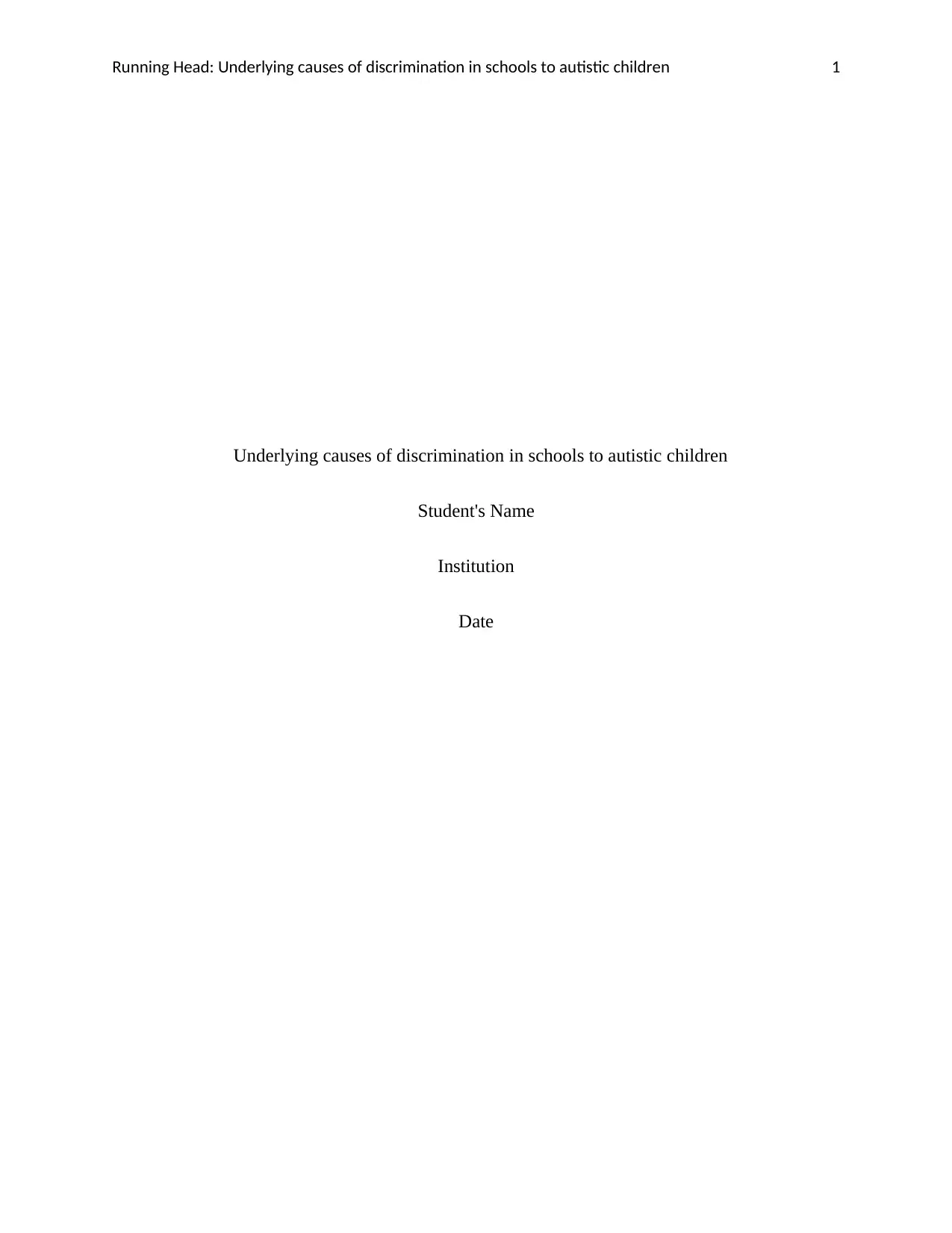
Running Head: Underlying causes of discrimination in schools to autistic children 1
Underlying causes of discrimination in schools to autistic children
Student's Name
Institution
Date
Underlying causes of discrimination in schools to autistic children
Student's Name
Institution
Date
Paraphrase This Document
Need a fresh take? Get an instant paraphrase of this document with our AI Paraphraser
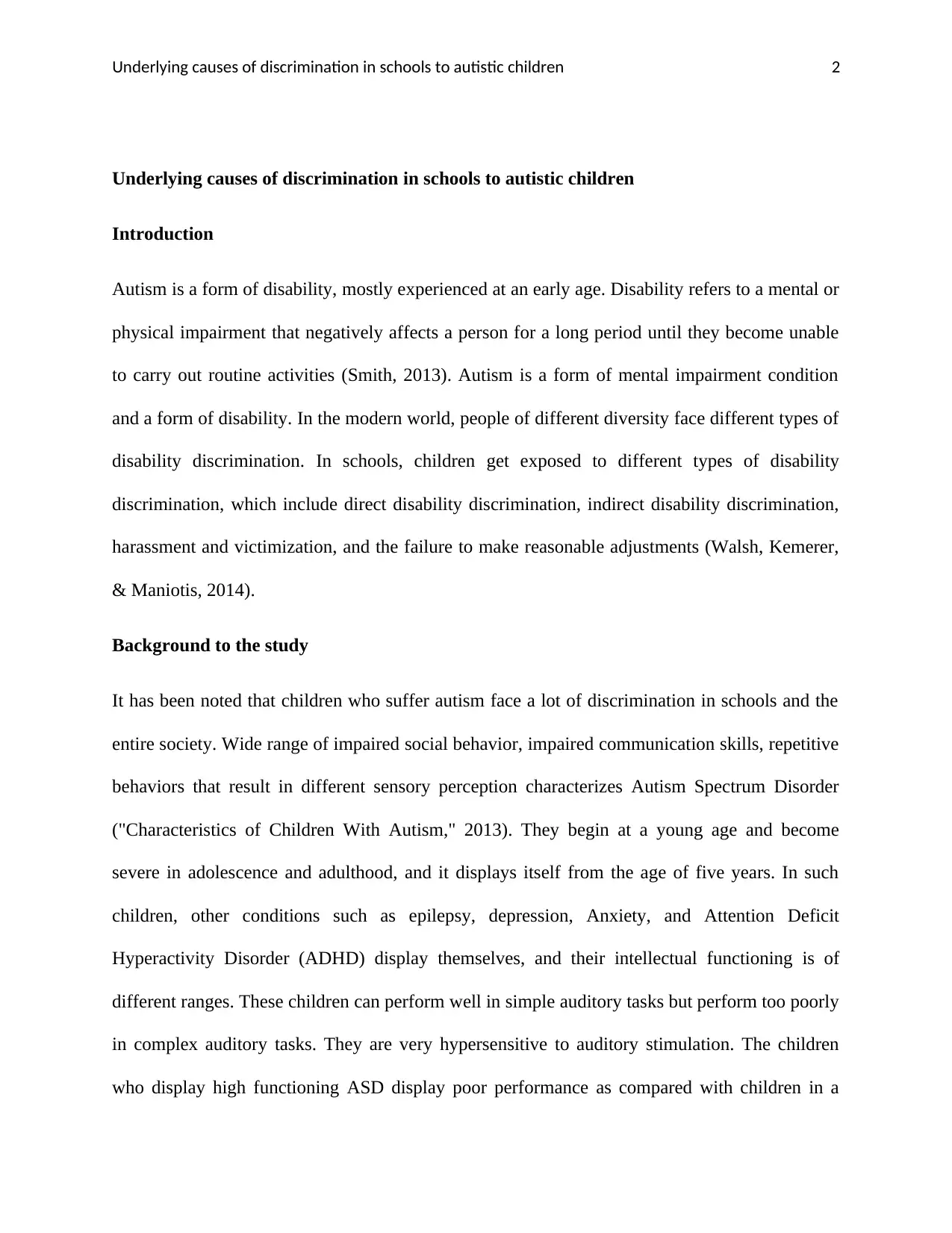
Underlying causes of discrimination in schools to autistic children 2
Underlying causes of discrimination in schools to autistic children
Introduction
Autism is a form of disability, mostly experienced at an early age. Disability refers to a mental or
physical impairment that negatively affects a person for a long period until they become unable
to carry out routine activities (Smith, 2013). Autism is a form of mental impairment condition
and a form of disability. In the modern world, people of different diversity face different types of
disability discrimination. In schools, children get exposed to different types of disability
discrimination, which include direct disability discrimination, indirect disability discrimination,
harassment and victimization, and the failure to make reasonable adjustments (Walsh, Kemerer,
& Maniotis, 2014).
Background to the study
It has been noted that children who suffer autism face a lot of discrimination in schools and the
entire society. Wide range of impaired social behavior, impaired communication skills, repetitive
behaviors that result in different sensory perception characterizes Autism Spectrum Disorder
("Characteristics of Children With Autism," 2013). They begin at a young age and become
severe in adolescence and adulthood, and it displays itself from the age of five years. In such
children, other conditions such as epilepsy, depression, Anxiety, and Attention Deficit
Hyperactivity Disorder (ADHD) display themselves, and their intellectual functioning is of
different ranges. These children can perform well in simple auditory tasks but perform too poorly
in complex auditory tasks. They are very hypersensitive to auditory stimulation. The children
who display high functioning ASD display poor performance as compared with children in a
Underlying causes of discrimination in schools to autistic children
Introduction
Autism is a form of disability, mostly experienced at an early age. Disability refers to a mental or
physical impairment that negatively affects a person for a long period until they become unable
to carry out routine activities (Smith, 2013). Autism is a form of mental impairment condition
and a form of disability. In the modern world, people of different diversity face different types of
disability discrimination. In schools, children get exposed to different types of disability
discrimination, which include direct disability discrimination, indirect disability discrimination,
harassment and victimization, and the failure to make reasonable adjustments (Walsh, Kemerer,
& Maniotis, 2014).
Background to the study
It has been noted that children who suffer autism face a lot of discrimination in schools and the
entire society. Wide range of impaired social behavior, impaired communication skills, repetitive
behaviors that result in different sensory perception characterizes Autism Spectrum Disorder
("Characteristics of Children With Autism," 2013). They begin at a young age and become
severe in adolescence and adulthood, and it displays itself from the age of five years. In such
children, other conditions such as epilepsy, depression, Anxiety, and Attention Deficit
Hyperactivity Disorder (ADHD) display themselves, and their intellectual functioning is of
different ranges. These children can perform well in simple auditory tasks but perform too poorly
in complex auditory tasks. They are very hypersensitive to auditory stimulation. The children
who display high functioning ASD display poor performance as compared with children in a
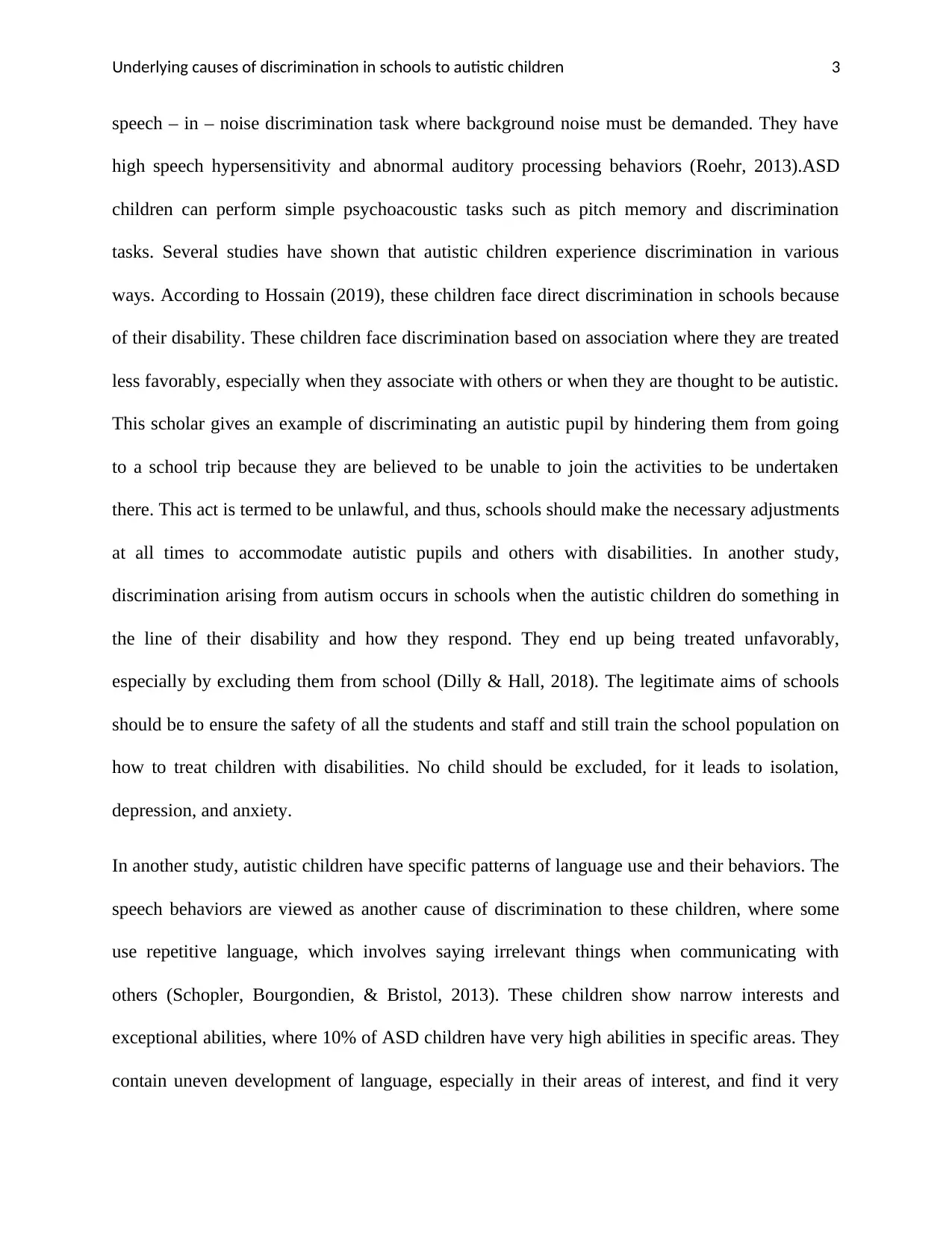
Underlying causes of discrimination in schools to autistic children 3
speech – in – noise discrimination task where background noise must be demanded. They have
high speech hypersensitivity and abnormal auditory processing behaviors (Roehr, 2013).ASD
children can perform simple psychoacoustic tasks such as pitch memory and discrimination
tasks. Several studies have shown that autistic children experience discrimination in various
ways. According to Hossain (2019), these children face direct discrimination in schools because
of their disability. These children face discrimination based on association where they are treated
less favorably, especially when they associate with others or when they are thought to be autistic.
This scholar gives an example of discriminating an autistic pupil by hindering them from going
to a school trip because they are believed to be unable to join the activities to be undertaken
there. This act is termed to be unlawful, and thus, schools should make the necessary adjustments
at all times to accommodate autistic pupils and others with disabilities. In another study,
discrimination arising from autism occurs in schools when the autistic children do something in
the line of their disability and how they respond. They end up being treated unfavorably,
especially by excluding them from school (Dilly & Hall, 2018). The legitimate aims of schools
should be to ensure the safety of all the students and staff and still train the school population on
how to treat children with disabilities. No child should be excluded, for it leads to isolation,
depression, and anxiety.
In another study, autistic children have specific patterns of language use and their behaviors. The
speech behaviors are viewed as another cause of discrimination to these children, where some
use repetitive language, which involves saying irrelevant things when communicating with
others (Schopler, Bourgondien, & Bristol, 2013). These children show narrow interests and
exceptional abilities, where 10% of ASD children have very high abilities in specific areas. They
contain uneven development of language, especially in their areas of interest, and find it very
speech – in – noise discrimination task where background noise must be demanded. They have
high speech hypersensitivity and abnormal auditory processing behaviors (Roehr, 2013).ASD
children can perform simple psychoacoustic tasks such as pitch memory and discrimination
tasks. Several studies have shown that autistic children experience discrimination in various
ways. According to Hossain (2019), these children face direct discrimination in schools because
of their disability. These children face discrimination based on association where they are treated
less favorably, especially when they associate with others or when they are thought to be autistic.
This scholar gives an example of discriminating an autistic pupil by hindering them from going
to a school trip because they are believed to be unable to join the activities to be undertaken
there. This act is termed to be unlawful, and thus, schools should make the necessary adjustments
at all times to accommodate autistic pupils and others with disabilities. In another study,
discrimination arising from autism occurs in schools when the autistic children do something in
the line of their disability and how they respond. They end up being treated unfavorably,
especially by excluding them from school (Dilly & Hall, 2018). The legitimate aims of schools
should be to ensure the safety of all the students and staff and still train the school population on
how to treat children with disabilities. No child should be excluded, for it leads to isolation,
depression, and anxiety.
In another study, autistic children have specific patterns of language use and their behaviors. The
speech behaviors are viewed as another cause of discrimination to these children, where some
use repetitive language, which involves saying irrelevant things when communicating with
others (Schopler, Bourgondien, & Bristol, 2013). These children show narrow interests and
exceptional abilities, where 10% of ASD children have very high abilities in specific areas. They
contain uneven development of language, especially in their areas of interest, and find it very
⊘ This is a preview!⊘
Do you want full access?
Subscribe today to unlock all pages.

Trusted by 1+ million students worldwide
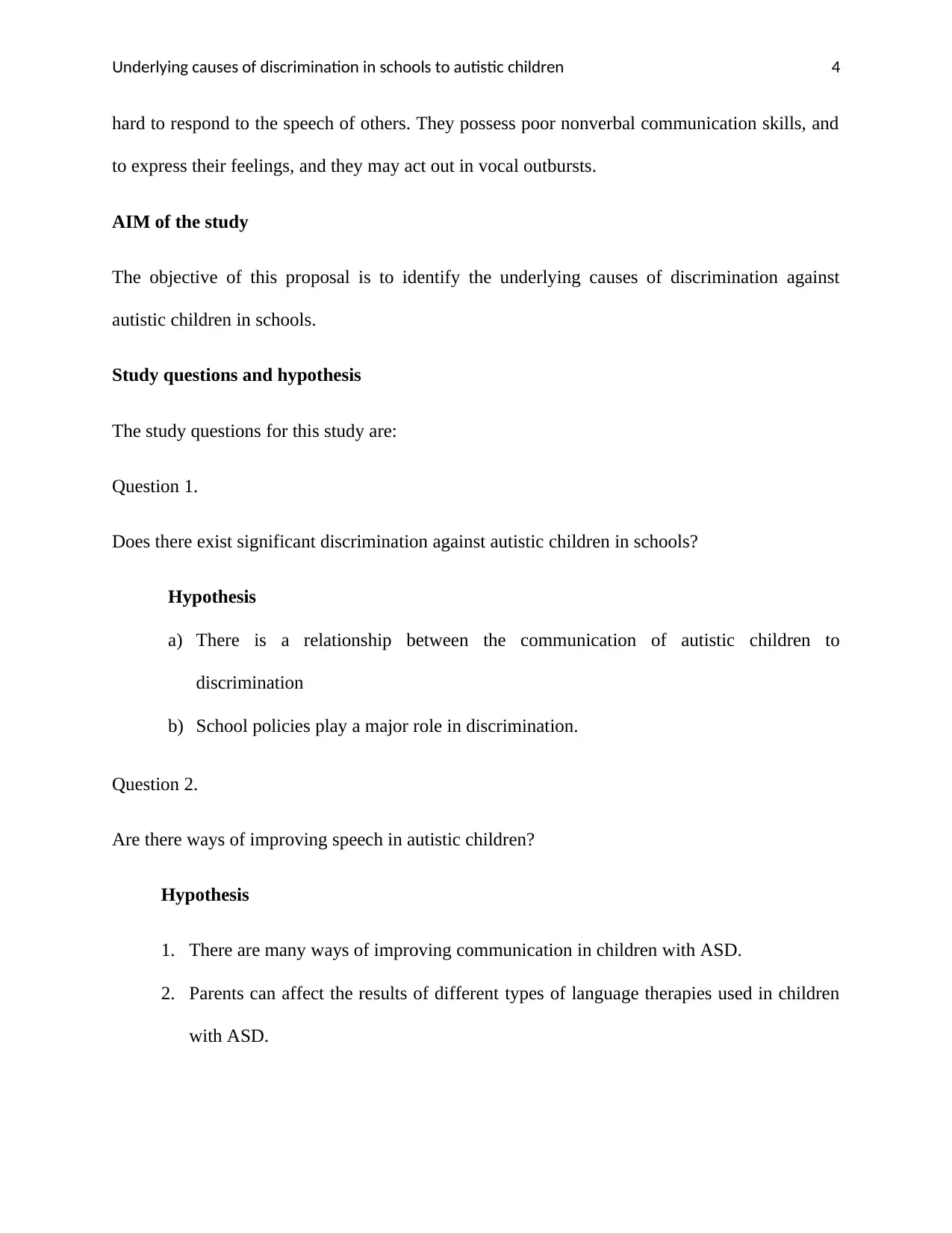
Underlying causes of discrimination in schools to autistic children 4
hard to respond to the speech of others. They possess poor nonverbal communication skills, and
to express their feelings, and they may act out in vocal outbursts.
AIM of the study
The objective of this proposal is to identify the underlying causes of discrimination against
autistic children in schools.
Study questions and hypothesis
The study questions for this study are:
Question 1.
Does there exist significant discrimination against autistic children in schools?
Hypothesis
a) There is a relationship between the communication of autistic children to
discrimination
b) School policies play a major role in discrimination.
Question 2.
Are there ways of improving speech in autistic children?
Hypothesis
1. There are many ways of improving communication in children with ASD.
2. Parents can affect the results of different types of language therapies used in children
with ASD.
hard to respond to the speech of others. They possess poor nonverbal communication skills, and
to express their feelings, and they may act out in vocal outbursts.
AIM of the study
The objective of this proposal is to identify the underlying causes of discrimination against
autistic children in schools.
Study questions and hypothesis
The study questions for this study are:
Question 1.
Does there exist significant discrimination against autistic children in schools?
Hypothesis
a) There is a relationship between the communication of autistic children to
discrimination
b) School policies play a major role in discrimination.
Question 2.
Are there ways of improving speech in autistic children?
Hypothesis
1. There are many ways of improving communication in children with ASD.
2. Parents can affect the results of different types of language therapies used in children
with ASD.
Paraphrase This Document
Need a fresh take? Get an instant paraphrase of this document with our AI Paraphraser

Underlying causes of discrimination in schools to autistic children 5
Research plan
Calculation of the sample size
The source of the interventions to autism in children shall be South Australian school, Aberfoyle
Hub Primary School. From the school, the records of children with autism shall be identified
during the audit and identify from their records the type of clinical interventions they receive
according to health standards. The calculation of the required number of children will be done
using the desired precision level of the compliance rate. Calculations shall be dependent on the
expected auditory – based interventions given and the desired precision that shall be estimated
with a set confidence level. The sample size calculation formula shall be: for a 95% level of
confidence and +5% accuracy, the following formula shall be used to calculate the sample size:
N=[z^2*N*p(1-p)]/[(0.05^2 *N)+(z^2*p(1-p].
The n represents the sample, while z^ is the abscissa of the normal curve. The normal curve cuts
off an area at the tails. The N is the population size, p the estimated proportion of the
intervention that should be given to autistic children. The proportional allocation shall be done to
allocate the sample size to the school. The 95% confidence level and 5% accuracy shall be used
to state whether there is the certainty of true value in the auditory – based interventions given to
children with autism estimated proportion of 90 to 100.
Participants
'more than50children aged between 5 to 7 years shall be recruited in the research. To recruit
these children, informed consent shall be sought from their parents and their guardians and the
individual children. After obtaining the permissions for participation, the children shall be
divided into two groups where group one shall be nvASD, and group 2 shall be vASD. These
Research plan
Calculation of the sample size
The source of the interventions to autism in children shall be South Australian school, Aberfoyle
Hub Primary School. From the school, the records of children with autism shall be identified
during the audit and identify from their records the type of clinical interventions they receive
according to health standards. The calculation of the required number of children will be done
using the desired precision level of the compliance rate. Calculations shall be dependent on the
expected auditory – based interventions given and the desired precision that shall be estimated
with a set confidence level. The sample size calculation formula shall be: for a 95% level of
confidence and +5% accuracy, the following formula shall be used to calculate the sample size:
N=[z^2*N*p(1-p)]/[(0.05^2 *N)+(z^2*p(1-p].
The n represents the sample, while z^ is the abscissa of the normal curve. The normal curve cuts
off an area at the tails. The N is the population size, p the estimated proportion of the
intervention that should be given to autistic children. The proportional allocation shall be done to
allocate the sample size to the school. The 95% confidence level and 5% accuracy shall be used
to state whether there is the certainty of true value in the auditory – based interventions given to
children with autism estimated proportion of 90 to 100.
Participants
'more than50children aged between 5 to 7 years shall be recruited in the research. To recruit
these children, informed consent shall be sought from their parents and their guardians and the
individual children. After obtaining the permissions for participation, the children shall be
divided into two groups where group one shall be nvASD, and group 2 shall be vASD. These
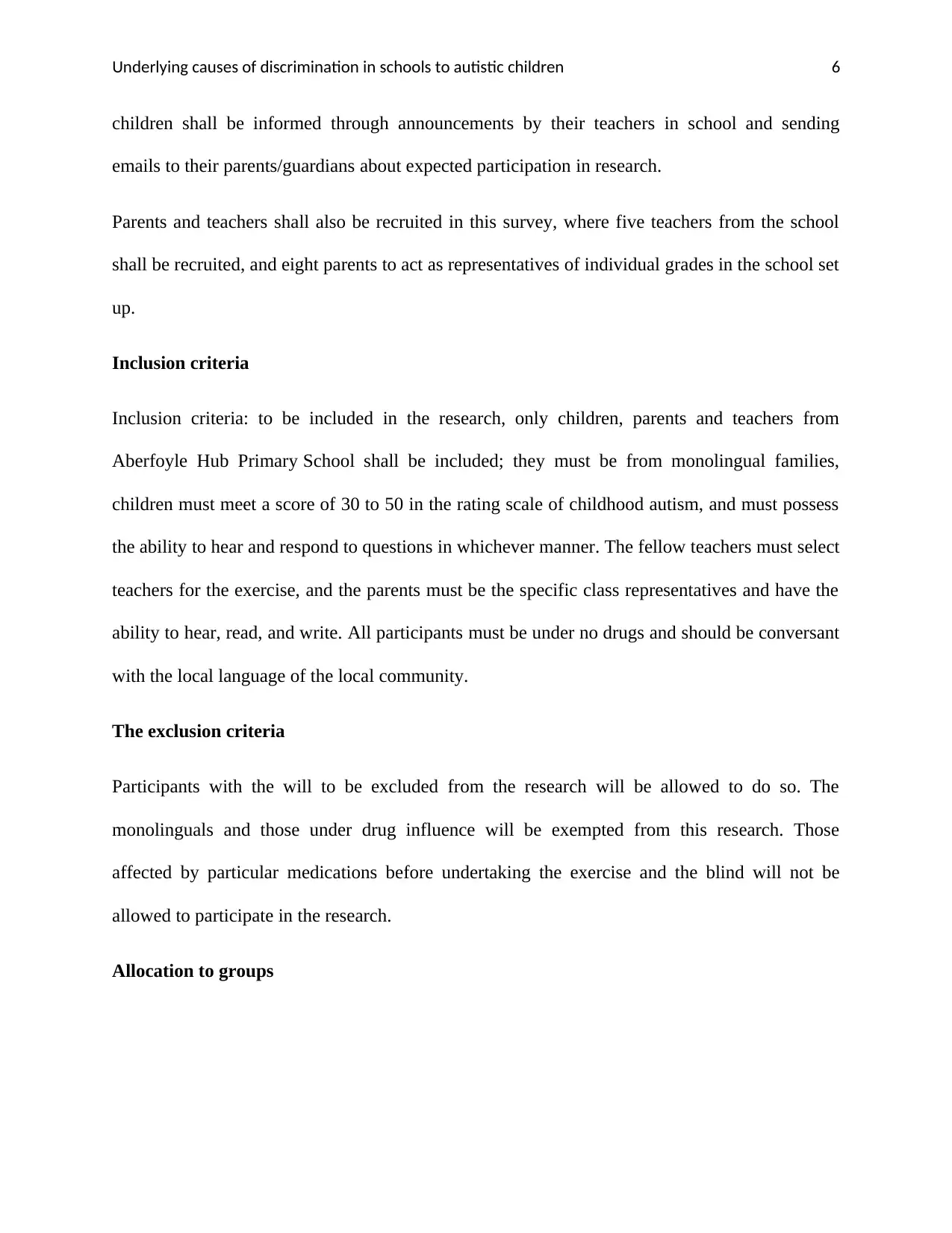
Underlying causes of discrimination in schools to autistic children 6
children shall be informed through announcements by their teachers in school and sending
emails to their parents/guardians about expected participation in research.
Parents and teachers shall also be recruited in this survey, where five teachers from the school
shall be recruited, and eight parents to act as representatives of individual grades in the school set
up.
Inclusion criteria
Inclusion criteria: to be included in the research, only children, parents and teachers from
Aberfoyle Hub Primary School shall be included; they must be from monolingual families,
children must meet a score of 30 to 50 in the rating scale of childhood autism, and must possess
the ability to hear and respond to questions in whichever manner. The fellow teachers must select
teachers for the exercise, and the parents must be the specific class representatives and have the
ability to hear, read, and write. All participants must be under no drugs and should be conversant
with the local language of the local community.
The exclusion criteria
Participants with the will to be excluded from the research will be allowed to do so. The
monolinguals and those under drug influence will be exempted from this research. Those
affected by particular medications before undertaking the exercise and the blind will not be
allowed to participate in the research.
Allocation to groups
children shall be informed through announcements by their teachers in school and sending
emails to their parents/guardians about expected participation in research.
Parents and teachers shall also be recruited in this survey, where five teachers from the school
shall be recruited, and eight parents to act as representatives of individual grades in the school set
up.
Inclusion criteria
Inclusion criteria: to be included in the research, only children, parents and teachers from
Aberfoyle Hub Primary School shall be included; they must be from monolingual families,
children must meet a score of 30 to 50 in the rating scale of childhood autism, and must possess
the ability to hear and respond to questions in whichever manner. The fellow teachers must select
teachers for the exercise, and the parents must be the specific class representatives and have the
ability to hear, read, and write. All participants must be under no drugs and should be conversant
with the local language of the local community.
The exclusion criteria
Participants with the will to be excluded from the research will be allowed to do so. The
monolinguals and those under drug influence will be exempted from this research. Those
affected by particular medications before undertaking the exercise and the blind will not be
allowed to participate in the research.
Allocation to groups
⊘ This is a preview!⊘
Do you want full access?
Subscribe today to unlock all pages.

Trusted by 1+ million students worldwide
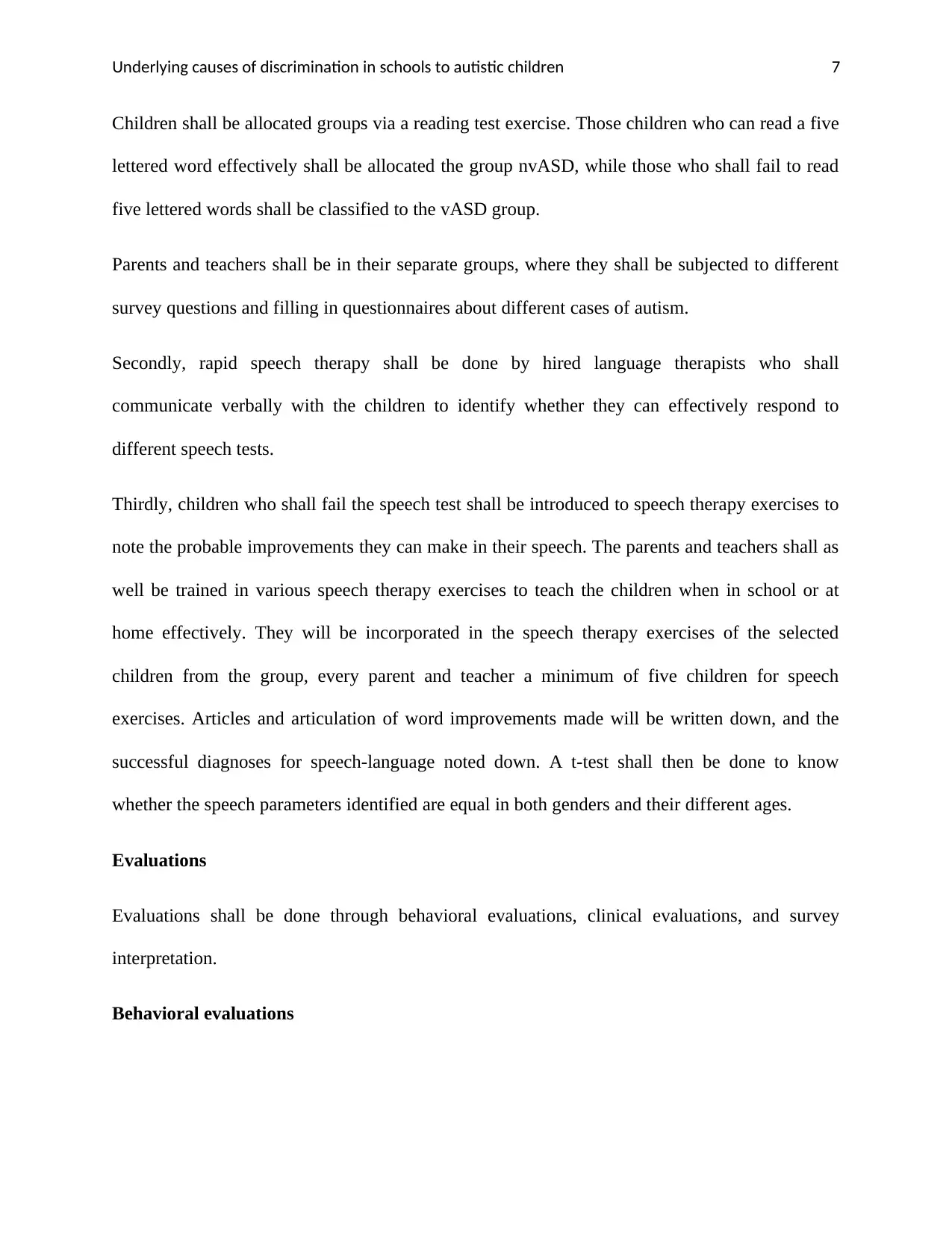
Underlying causes of discrimination in schools to autistic children 7
Children shall be allocated groups via a reading test exercise. Those children who can read a five
lettered word effectively shall be allocated the group nvASD, while those who shall fail to read
five lettered words shall be classified to the vASD group.
Parents and teachers shall be in their separate groups, where they shall be subjected to different
survey questions and filling in questionnaires about different cases of autism.
Secondly, rapid speech therapy shall be done by hired language therapists who shall
communicate verbally with the children to identify whether they can effectively respond to
different speech tests.
Thirdly, children who shall fail the speech test shall be introduced to speech therapy exercises to
note the probable improvements they can make in their speech. The parents and teachers shall as
well be trained in various speech therapy exercises to teach the children when in school or at
home effectively. They will be incorporated in the speech therapy exercises of the selected
children from the group, every parent and teacher a minimum of five children for speech
exercises. Articles and articulation of word improvements made will be written down, and the
successful diagnoses for speech-language noted down. A t-test shall then be done to know
whether the speech parameters identified are equal in both genders and their different ages.
Evaluations
Evaluations shall be done through behavioral evaluations, clinical evaluations, and survey
interpretation.
Behavioral evaluations
Children shall be allocated groups via a reading test exercise. Those children who can read a five
lettered word effectively shall be allocated the group nvASD, while those who shall fail to read
five lettered words shall be classified to the vASD group.
Parents and teachers shall be in their separate groups, where they shall be subjected to different
survey questions and filling in questionnaires about different cases of autism.
Secondly, rapid speech therapy shall be done by hired language therapists who shall
communicate verbally with the children to identify whether they can effectively respond to
different speech tests.
Thirdly, children who shall fail the speech test shall be introduced to speech therapy exercises to
note the probable improvements they can make in their speech. The parents and teachers shall as
well be trained in various speech therapy exercises to teach the children when in school or at
home effectively. They will be incorporated in the speech therapy exercises of the selected
children from the group, every parent and teacher a minimum of five children for speech
exercises. Articles and articulation of word improvements made will be written down, and the
successful diagnoses for speech-language noted down. A t-test shall then be done to know
whether the speech parameters identified are equal in both genders and their different ages.
Evaluations
Evaluations shall be done through behavioral evaluations, clinical evaluations, and survey
interpretation.
Behavioral evaluations
Paraphrase This Document
Need a fresh take? Get an instant paraphrase of this document with our AI Paraphraser
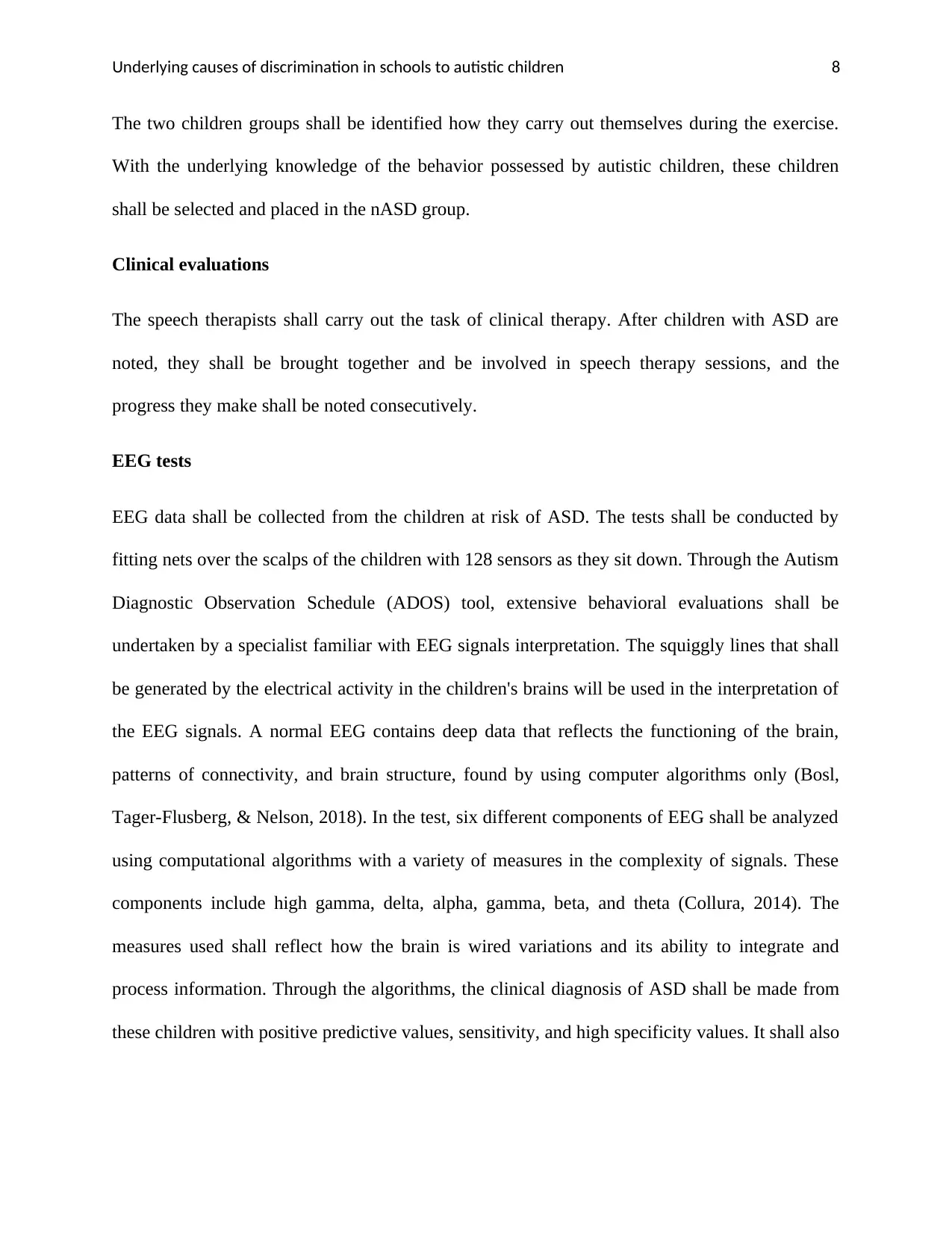
Underlying causes of discrimination in schools to autistic children 8
The two children groups shall be identified how they carry out themselves during the exercise.
With the underlying knowledge of the behavior possessed by autistic children, these children
shall be selected and placed in the nASD group.
Clinical evaluations
The speech therapists shall carry out the task of clinical therapy. After children with ASD are
noted, they shall be brought together and be involved in speech therapy sessions, and the
progress they make shall be noted consecutively.
EEG tests
EEG data shall be collected from the children at risk of ASD. The tests shall be conducted by
fitting nets over the scalps of the children with 128 sensors as they sit down. Through the Autism
Diagnostic Observation Schedule (ADOS) tool, extensive behavioral evaluations shall be
undertaken by a specialist familiar with EEG signals interpretation. The squiggly lines that shall
be generated by the electrical activity in the children's brains will be used in the interpretation of
the EEG signals. A normal EEG contains deep data that reflects the functioning of the brain,
patterns of connectivity, and brain structure, found by using computer algorithms only (Bosl,
Tager-Flusberg, & Nelson, 2018). In the test, six different components of EEG shall be analyzed
using computational algorithms with a variety of measures in the complexity of signals. These
components include high gamma, delta, alpha, gamma, beta, and theta (Collura, 2014). The
measures used shall reflect how the brain is wired variations and its ability to integrate and
process information. Through the algorithms, the clinical diagnosis of ASD shall be made from
these children with positive predictive values, sensitivity, and high specificity values. It shall also
The two children groups shall be identified how they carry out themselves during the exercise.
With the underlying knowledge of the behavior possessed by autistic children, these children
shall be selected and placed in the nASD group.
Clinical evaluations
The speech therapists shall carry out the task of clinical therapy. After children with ASD are
noted, they shall be brought together and be involved in speech therapy sessions, and the
progress they make shall be noted consecutively.
EEG tests
EEG data shall be collected from the children at risk of ASD. The tests shall be conducted by
fitting nets over the scalps of the children with 128 sensors as they sit down. Through the Autism
Diagnostic Observation Schedule (ADOS) tool, extensive behavioral evaluations shall be
undertaken by a specialist familiar with EEG signals interpretation. The squiggly lines that shall
be generated by the electrical activity in the children's brains will be used in the interpretation of
the EEG signals. A normal EEG contains deep data that reflects the functioning of the brain,
patterns of connectivity, and brain structure, found by using computer algorithms only (Bosl,
Tager-Flusberg, & Nelson, 2018). In the test, six different components of EEG shall be analyzed
using computational algorithms with a variety of measures in the complexity of signals. These
components include high gamma, delta, alpha, gamma, beta, and theta (Collura, 2014). The
measures used shall reflect how the brain is wired variations and its ability to integrate and
process information. Through the algorithms, the clinical diagnosis of ASD shall be made from
these children with positive predictive values, sensitivity, and high specificity values. It shall also
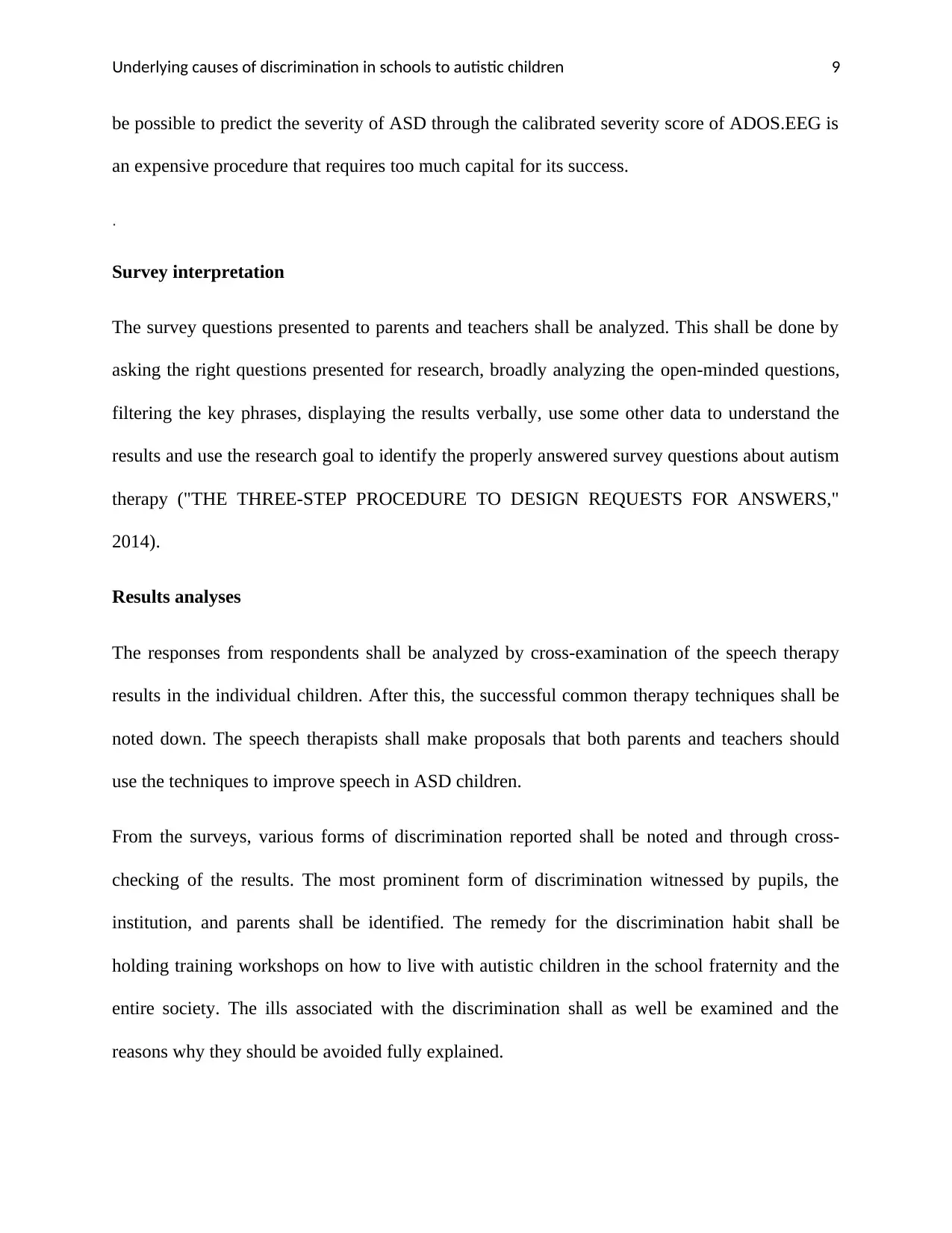
Underlying causes of discrimination in schools to autistic children 9
be possible to predict the severity of ASD through the calibrated severity score of ADOS.EEG is
an expensive procedure that requires too much capital for its success.
.
Survey interpretation
The survey questions presented to parents and teachers shall be analyzed. This shall be done by
asking the right questions presented for research, broadly analyzing the open-minded questions,
filtering the key phrases, displaying the results verbally, use some other data to understand the
results and use the research goal to identify the properly answered survey questions about autism
therapy ("THE THREE-STEP PROCEDURE TO DESIGN REQUESTS FOR ANSWERS,"
2014).
Results analyses
The responses from respondents shall be analyzed by cross-examination of the speech therapy
results in the individual children. After this, the successful common therapy techniques shall be
noted down. The speech therapists shall make proposals that both parents and teachers should
use the techniques to improve speech in ASD children.
From the surveys, various forms of discrimination reported shall be noted and through cross-
checking of the results. The most prominent form of discrimination witnessed by pupils, the
institution, and parents shall be identified. The remedy for the discrimination habit shall be
holding training workshops on how to live with autistic children in the school fraternity and the
entire society. The ills associated with the discrimination shall as well be examined and the
reasons why they should be avoided fully explained.
be possible to predict the severity of ASD through the calibrated severity score of ADOS.EEG is
an expensive procedure that requires too much capital for its success.
.
Survey interpretation
The survey questions presented to parents and teachers shall be analyzed. This shall be done by
asking the right questions presented for research, broadly analyzing the open-minded questions,
filtering the key phrases, displaying the results verbally, use some other data to understand the
results and use the research goal to identify the properly answered survey questions about autism
therapy ("THE THREE-STEP PROCEDURE TO DESIGN REQUESTS FOR ANSWERS,"
2014).
Results analyses
The responses from respondents shall be analyzed by cross-examination of the speech therapy
results in the individual children. After this, the successful common therapy techniques shall be
noted down. The speech therapists shall make proposals that both parents and teachers should
use the techniques to improve speech in ASD children.
From the surveys, various forms of discrimination reported shall be noted and through cross-
checking of the results. The most prominent form of discrimination witnessed by pupils, the
institution, and parents shall be identified. The remedy for the discrimination habit shall be
holding training workshops on how to live with autistic children in the school fraternity and the
entire society. The ills associated with the discrimination shall as well be examined and the
reasons why they should be avoided fully explained.
⊘ This is a preview!⊘
Do you want full access?
Subscribe today to unlock all pages.

Trusted by 1+ million students worldwide

Underlying causes of discrimination in schools to autistic children 10
This research shall be carried out by following ethical considerations of any research carried out
in any organization. These ethical considerations include seeking informed consent, ensuring
security to the respondents, ensuring their right to privacy and confidentiality (Hoover & Buzdar,
2017).
References
Bosl, W. J., Tager-Flusberg, H., & Nelson, C. A. (2018). EEG Analytics for Early Detection of
Autism Spectrum Disorder: A data-driven approach. Scientific Reports, 8(1).
doi:10.1038/s41598-018-24318-x
Characteristics of Children With Autism. (2013). Teaching Children with High-Level Autism,
19-34. doi:10.4324/9780203762356-3
Collura, T. F. (2014). EEG Components and Their Properties. Technical Foundations of
Neurofeedback, 103-115. doi:10.4324/9780203795132-5
Dilly, L. J., & Hall, C. M. (2018). Autism Spectrum Disorder Assessment in Schools.
doi:10.4324/9781351242455
Hoover, T. C., & Buzdar, A. (2017). Ethical Considerations in Human Subjects
Research. Ethical Challenges in Oncology, 145-157. doi:10.1016/b978-0-12-803831-
4.00009-9
Hossain, I. (2019). Life skill Development of Autistic Children Following Education Therapy in
Specialized Schools. TEXILA INTERNATIONAL JOURNAL OF PUBLIC
HEALTH, 7(1), 44-50. doi:10.21522/tijph.2013.07.01.art005
This research shall be carried out by following ethical considerations of any research carried out
in any organization. These ethical considerations include seeking informed consent, ensuring
security to the respondents, ensuring their right to privacy and confidentiality (Hoover & Buzdar,
2017).
References
Bosl, W. J., Tager-Flusberg, H., & Nelson, C. A. (2018). EEG Analytics for Early Detection of
Autism Spectrum Disorder: A data-driven approach. Scientific Reports, 8(1).
doi:10.1038/s41598-018-24318-x
Characteristics of Children With Autism. (2013). Teaching Children with High-Level Autism,
19-34. doi:10.4324/9780203762356-3
Collura, T. F. (2014). EEG Components and Their Properties. Technical Foundations of
Neurofeedback, 103-115. doi:10.4324/9780203795132-5
Dilly, L. J., & Hall, C. M. (2018). Autism Spectrum Disorder Assessment in Schools.
doi:10.4324/9781351242455
Hoover, T. C., & Buzdar, A. (2017). Ethical Considerations in Human Subjects
Research. Ethical Challenges in Oncology, 145-157. doi:10.1016/b978-0-12-803831-
4.00009-9
Hossain, I. (2019). Life skill Development of Autistic Children Following Education Therapy in
Specialized Schools. TEXILA INTERNATIONAL JOURNAL OF PUBLIC
HEALTH, 7(1), 44-50. doi:10.21522/tijph.2013.07.01.art005
Paraphrase This Document
Need a fresh take? Get an instant paraphrase of this document with our AI Paraphraser

Underlying causes of discrimination in schools to autistic children 11
Roehr, B. (2013). American Psychiatric Association explains DSM-5. BMJ, 346(jun06 1),
f3591-f3591. doi:10.1136/bmj.f3591
Schopler, E., Bourgondien, M. E., & Bristol, M. M. (2013). Preschool Issues in Autism. Berlin,
Germany: Springer Science & Business Media.
Smith, D. N. (2013). Basic Equality and Discrimination: Reconciling Theory and Law. Surrey,
England: Ashgate Publishing.
THE THREE-STEP PROCEDURE TO DESIGN REQUESTS FOR ANSWERS.
(2014). Design, Evaluation, and Analysis of Questionnaires for Survey Research, 13-13.
doi:10.1002/9781118634646.part1
Walsh, J., Kemerer, F., & Maniotis, L. (2014). The Educator's Guide to Texas School Law:
Eighth Edition. Austin, TX: University of Texas Press.
Roehr, B. (2013). American Psychiatric Association explains DSM-5. BMJ, 346(jun06 1),
f3591-f3591. doi:10.1136/bmj.f3591
Schopler, E., Bourgondien, M. E., & Bristol, M. M. (2013). Preschool Issues in Autism. Berlin,
Germany: Springer Science & Business Media.
Smith, D. N. (2013). Basic Equality and Discrimination: Reconciling Theory and Law. Surrey,
England: Ashgate Publishing.
THE THREE-STEP PROCEDURE TO DESIGN REQUESTS FOR ANSWERS.
(2014). Design, Evaluation, and Analysis of Questionnaires for Survey Research, 13-13.
doi:10.1002/9781118634646.part1
Walsh, J., Kemerer, F., & Maniotis, L. (2014). The Educator's Guide to Texas School Law:
Eighth Edition. Austin, TX: University of Texas Press.
1 out of 11
Your All-in-One AI-Powered Toolkit for Academic Success.
+13062052269
info@desklib.com
Available 24*7 on WhatsApp / Email
![[object Object]](/_next/static/media/star-bottom.7253800d.svg)
Unlock your academic potential
Copyright © 2020–2025 A2Z Services. All Rights Reserved. Developed and managed by ZUCOL.
